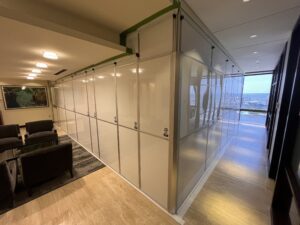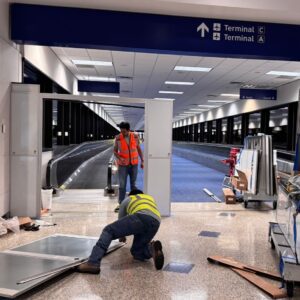How Airports Use Temporary Walls for Security and Expansion Projects
Airports are among the busiest and most complex environments in the world, juggling security concerns, relentless passenger traffic, and ongoing renovation projects, all without disruption to operations. With millions of travelers passing through each year, airports are constantly expanding and upgrading to improve efficiency and adhere to the latest security protocols.
But how do airports maintain order, prioritize safety, and carry out construction projects without compromising passenger experiences? Enter temporary wall systems. These versatile solutions are now a key asset for airports, providing a practical way to manage security screening, facilitate expansions, and create modular spaces.
Here’s a closer look at how temporary walls are being used to meet the unique challenges of modern airports.
Addressing Security Challenges in Airports
Managing Growth and Expansion
Airports worldwide are experiencing unprecedented growth in passenger numbers. According to Airports Council International, global air traffic is projected to grow by 4.2% annually, reaching nearly 20 billion passengers by 2040. This surge in traffic brings challenges, from overcrowding to operational inefficiencies.
To accommodate this growth, airports need to expand facilities, add security screening zones, and update infrastructure. However, such projects take years to complete, and closing sections of an airport during renovations creates significant disruption. Airports must strike a balance between accommodating passengers and maintaining security protocols during such expansion efforts.
Staffing Strains and Security
Security remains a pressing concern, with airports under constant pressure to protect passengers from evolving threats. To make matters more complex, many airports face staffing shortages, further complicating their ability to operate efficiently while tackling renovation or expansion projects.
This is where temporary solutions offer tremendous value, providing both flexibility and efficiency.
The Role of Temporary Walls in Airport Operations
Creating Temporary Security Screening Areas
Modern temporary wall systems are increasingly being used to create entirely new spaces within airports. One common application is the construction of temporary security screening zones during peak travel seasons or renovation periods.
- Enhanced Flexibility: Temporary walls allow airports to swiftly adapt to changing passenger volumes by setting up additional screening areas or expanding existing spaces.
- Minimized Disruption: These walls are quiet to install, ensuring minimal interruption to travelers and staff.
- Integration with Existing Infrastructure: Modular wall systems can be customized to complement existing layouts, creating functional spaces equipped with necessary security equipment.
By creating temporary, enclosed areas for security checks, airports can streamline the flow of passengers while upholding regulatory standards.
Containing Construction Projects for Expansions
Ongoing improvement projects are integral to every major airport. Whether it’s a new terminal, enhanced baggage claim area, or improved concourses, construction projects are almost always happening behind the scenes. Temporary wall systems are critical in this process.
- Dust and Noise Containment: Renovation projects within bustling airports generate dust, debris, and noise, all of which can inconvenience passengers. Temporary walls effectively enclose construction zones, ensuring the rest of the airport remains clean and quiet.
- Safety Assurance: Temporary walls keep passengers away from construction areas, minimizing safety risks. Robust wall panels ensure that restricted zones remain accessible only to authorized personnel.
- Professional Branding: Many temporary wall systems can be customized with airport branding or signage, seamlessly integrating construction sites into the overall airport aesthetic.
For airports aiming to meet tight construction deadlines while maintaining an excellent passenger experience, the value of temporary walls cannot be overstated.
Simplified Deployment with Turn-Key Solutions
Temporary wall systems are not just effective; they’re also remarkably easy to implement. Here’s why they are becoming the go-to solution for aviation hubs:
- Quick Installation: Temporary walls require fewer tools and less labor compared to traditional drywall construction. This means they can go up quickly, saving precious time.
- Effortless Removal: When construction or renovations are complete, the walls can be seamlessly taken down without damaging existing structures.
- Turn-Key Service: Companies like Temporary Wall Systems handle everything from delivery to installation and removal. This allows airport staff to focus on operations rather than logistical hurdles.
- Reusability for Sustainability: Many of these walls are reusable, aligning with aviation industry goals to reduce environmental impact.
This adaptability and efficiency make temporary systems ideal for airports that need to operate around the clock while undergoing modernization efforts.
Why Airports Choose Temporary Walls
Temporary wall systems offer a range of benefits that are uniquely suited to airport environments. Here’s what sets them apart:
- Speed: These walls can be installed in a fraction of the time required for traditional setups, minimizing disruption to airport traffic.
- Cost-Effectiveness: Requiring fewer materials and simpler installation, temporary walls save both time and money.
- Customizable Designs: Modular panels can be tailored for various needs, from providing soundproofing for quiet zones to creating visually appealing facades for passengers.
- Compliance with Regulations: Portable wall systems can be used in high-security areas without compromising on access control and safety.
Airports need solutions that are both versatile and durable, and temporary walls consistently deliver on both fronts.
The Future of Airport Modernization
Temporary wall systems are more than just a logistical convenience. They represent a shift towards modular, adaptable infrastructure that aligns with the dynamic needs of the aviation industry.
With passenger volumes expected to rise, and airports under increasing pressure to modernize quickly, temporary walls will continue to play an essential role in ensuring smooth operations during expansion and renovation projects.
If your airport is undergoing development or looking for ways to optimize its spaces, temporary wall solutions are worth considering. These systems not only solve operational challenges but also enhance the experience for passengers and staff alike.


